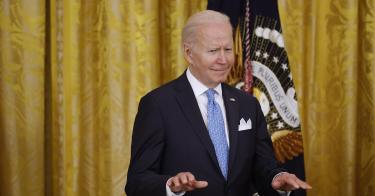The Biden administration has extended the “pause” on student loan payments for a sixth time. By the time the latest pause ends, those who took out student loans will have been able to go 30 months—two-and-a-half years—without making a single payment nor accruing any new interest.
It’s a raw deal for taxpayers. The Department of Education estimates that, each month, they are losing over $200 billion in repayments and another $5 billion in accrued interest. Since the beginning of the pandemic, the pause has cost taxpayers more than $130 billion in interest payments.
As if that were not sufficient largesse, President Biden is now considering outright “forgiveness” of some portion of all student loan balances. Here, “forgiveness" is a euphemism for a taxpayer-funded bailout. It’s bad policy from any angle.
First, it’s incredibly regressive. The Urban Institute found that “most outstanding student loan debt is held by people with relatively high incomes. … [It] is disproportionately concentrated among the well off.” While lower-income households make a up a larger share of borrowers, upper-income households make up a larger share of outstanding student loan debt. That’s because nearly half (48 percent) of student loan debt is held by households whose borrowers earned graduate degrees. Professional degree holders (doctors and lawyers, for example) earn a median annual salary of $96,772, far more than those who did not attend or graduate college.
>>> Biden’s Kowtowing on Student Loans Doubly Hurts Low-Income Taxpayers
The more generous student loan forgiveness becomes, the more it benefits upper income earners. The Federal Reserve Bank of New York recently estimated that 30 percent of loan forgiveness would go to borrowers from high-income neighborhoods. The University of Chicago finds that loan forgiveness would benefit the top 10 percent of income earners as much as the bottom 30 percent of income earners combined.
Second, it’s expensive. The Federal Reserve analysis found that forgiveness of $50,000 per borrower would cost $904 billion; forgiveness of $10,000 per borrower would cost an estimated $321 billion. Cumulative outstanding student loan debt currently hovers around $1.7 trillion, of which $1.38 trillion is federal. Already saddled with a $30.4 trillion debt, America cannot afford to gift hundreds of billions more to people who are comfortably off. It would only add to inflation.
Finally, there is the moral hazard. Student loan forgiveness would likely encourage colleges to raise tuition even higher—particularly if graduates expect student loans to be forgiven again in the future. Indeed, if current student loan balances are forgiven, why wouldn’t today’s students borrow the maximum amount allowed to attend the most expensive school possible, with the expectation that their debt will also be forgiven in the future?
Student loan forgiveness is unfair to those who chose not to attend college, those who worked their way through college to avoid taking on debt, and those who paid off their debt as promised. Forty-four percent of students who began a four-year degree in 2009 did not borrow anything to attend, and one-quarter borrowed less than $10,000. Having chosen not to take on debt, they should not now be asked to repay a loan they never took out.
And then there are the broader economic impacts. Regarding inflation, both the moratorium and broader forgiveness are gasoline on the fire. Absolving people of a debt reduces the incentive to work and reduces participation in the labor market. That retards economic output and drives up prices. Furthermore, repaying student loans would help reduce the money supply, taking the oxygen away from the inflationary fire and helping to keep down prices.
For most borrowers, student loan payments are manageable. The median monthly payment is $222 per month. And income-based repayment plans already exist for borrowers who need help making their payments.
>>> Congress’ Overspending Is the Problem, Not a Lack of Tax Dollars
No other form of debt is so lenient. Your mortgage or rent payments aren’t automatically reduced if your income declines. And those holding large student loan balances are usually graduate students and those pursuing professional degrees—the people most likely to earn high incomes in the future. So why should we ask Americans who did not or could not attend college to pay the expenses of those who did?
It's not like college graduates have been hit especially hard by the pandemic. The vast majority remained in their jobs by virtue of remote work, and their unemployment rate is a mere two percent. Some 1.7 million more college grads have jobs today than before the pandemic.
When the pause on student loan repayments ends in August, it should not be renewed a seventh time. And the Biden administration should abandon its misguided, regressive, expensive, inflationary, and morally hazardous pursuit of student loan forgiveness. The president may think it politically expedient, but the long-term consequences would be disastrous.
This piece originally appeared in Fox News




